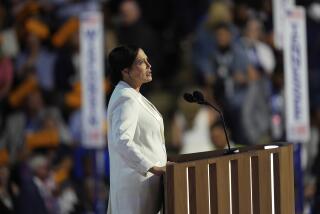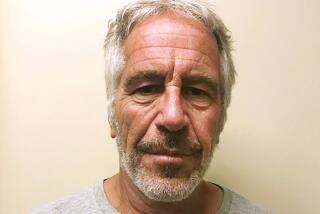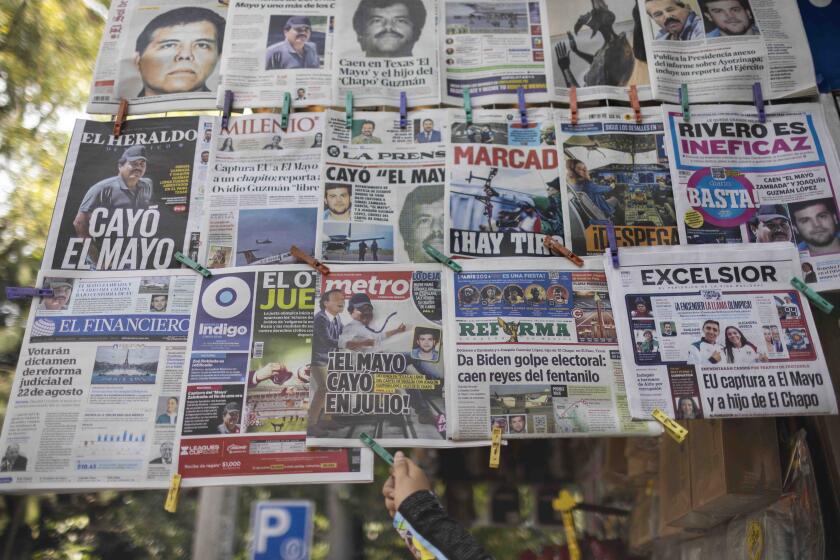Examining torture in the Bush era
Dick Cheney is right. President Obama should release any evidence the government has that shows whether torture -- sorry, “enhanced interrogation techniques” -- induced Al Qaeda detainees to give up information that saved American lives.
But Obama shouldn’t stop there.
Cheney has called for the release of memos he remembers from his days as vice president -- presumably the periodic can-do reports the Central Intelligence Agency sent over to show that its hard-nosed interrogations were producing good results.
Those memos are only a starting point. There’s also a secret 2004 report from the CIA’s inspector general that described the interrogations in such horrifying terms that then-CIA Director George J. Tenet immediately suspended the program he had created. And there are secret memos from officials in the Defense and State departments questioning whether the abuse of prisoners was producing anything that couldn’t have been learned through less ugly methods.
All those documents and more should be declassified and released so that our own government can see more clearly what it has done and learn from its mistakes.
The Bush administration’s terrorist-detainee programs -- the wholesale arrests of thousands in Afghanistan, the “rendition” of suspects to other countries, the secret imprisonment of detainees without legal review and the use of waterboarding, humiliation and other harsh interrogation measures -- add up to the most serious violations of civil liberties by a U.S. government in a generation. They deserve some sunlight.
But there’s a reason Cheney, no fan of government openness, is calling for more disclosures. The reality of defending the United States against terrorists -- and most of the remaining detainees at Guantanamo are, in fact, terrorists -- may make the balance of morality in these situations a bit more ambiguous.
In 2002, when Pakistani authorities captured Al Qaeda logistics chief Abu Zubaydah, CIA officials suspected he knew what Al Qaeda was planning next, as well as the whereabouts of Osama bin Laden. When Abu Zubaydah didn’t give up that information under conventional interrogation, the CIA sought permission to use physical force.
Abu Zubaydah, after all, had been involved in the advance planning for the 9/11 attacks against New York and Washington. There was little chance for calm deliberation. “They [CIA officials] came in and said, ‘We think this will work, this is the only way he will talk,’ ” recalled a former official who was in the White House at the time. “The threat streams [of incoming intelligence warnings were] extremely active. There’s discussion of a radiological attack. ... They are saying this thing could happen any day -- this is urgent, this is urgent.”
It turned out that Abu Zubaydah didn’t know as much as the CIA thought he did -- or at least not that he spilled. In hindsight, subjecting him to physical abuse was wrong. But was it justifiable at the time? Not such an easy call.
One measure the Bush administration offered to evaluate physical treatment of detainees was whether it “shocks the conscience,” a basic test in American legal proceedings. But it’s a flexible principle, by design. Whether a particular action shocks the conscience depends on the context -- on whether the interrogator thinks thousands of lives are at stake.
Former officials have sought to defend their decision to authorize physical abuse of prisoners -- a decision that all of President Bush’s principal foreign policy aides initially acceded to -- on the grounds that the brutality produced information that saved American lives. But not all of their claims have proved airtight.
Last week, some former officials asserted that the waterboarding of Khalid Shaikh Mohammed enabled the CIA to stop Al Qaeda from bombing Los Angeles’ Library Tower (now the US Bank Tower). But the plot was actually foiled months earlier, according to Bush’s own counter-terrorism chief. A more solid claim appears to be that Mohammed gave up the names of other suspects, who in turn gave up the names of others. Was that worth the cost? We don’t know.
Of course, the question is not whether abusive interrogations produced any useful information. It’s whether the abuse produced information that could not have been learned any other way, and whether the value of the information outweighed the damage to its victims: the detainees and the U.S. legal system.
A little-known facet of Bush’s detainee program is that it touched off furious debate inside the administration, including in-house revolts by lawyers at the Justice, Defense and State departments. Several times, Bush’s national security advisors -- first Condoleezza Rice, then Stephen Hadley -- asked the CIA to report whether the program was still necessary and useful. Four successive CIA chiefs -- Tenet, John McLaughlin, Porter J. Goss and Michael V. Hayden -- all reported that the program was crucial and should continue.
That doesn’t mean they had no qualms. In 2004, CIA Inspector General John L. Helgerson issued a secret report charging major abuses of detainees, including several deaths of prisoners in Afghanistan and Iraq. The report was so stinging, one former official said, that Tenet actually suspended “enhanced interrogations” for a time. And the CIA reportedly commissioned several secret audits of the program, including one by a former Clinton administration official, John J. Hamre -- but shared the results with almost no one outside the agency, perhaps to avoid giving ammunition to potential critics.
There appear to have been two centers of adamant resistance to second thoughts. One, which has been chronicled in several books, was the insistence by Cheney and his chief counsel, David S. Addington, that presidential decisions were beyond challenge, even by his own aides. The other, less examined until now, was the CIA’s insistence that violent interrogations were both necessary and useful -- right up until Jan. 22, when Obama outlawed the practice.
The central question today isn’t whether some CIA contractors overstepped the blurry lines of their rule book, or whether a few pliable lawyers in the Justice Department produced legal opinions to satisfy their bosses. We know they did. Now we need to ask why the government was unable to correct an erroneous course for seven years, except when the Supreme Court forced it to -- and then only minimally. We don’t need criminal prosecutions; we need public accountability at the top. Starting, for example, with public testimony from Dick Cheney.
More to Read
Sign up for Essential California
The most important California stories and recommendations in your inbox every morning.
You may occasionally receive promotional content from the Los Angeles Times.











